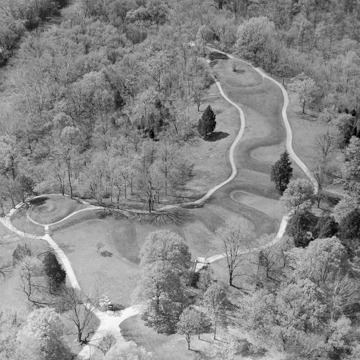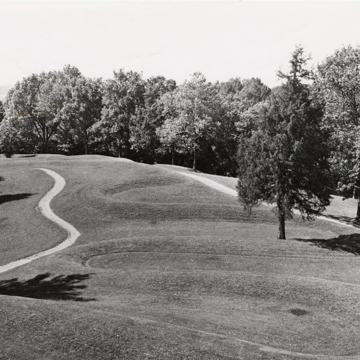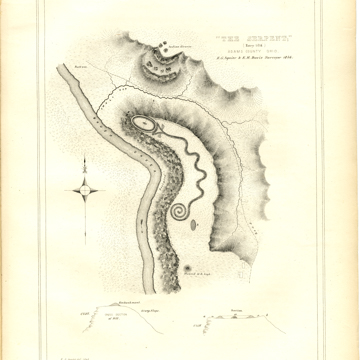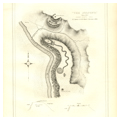Located in southwestern Ohio in rural Adams County, Serpent Mound encompasses the monumental eponymous mound as well as three smaller mounds, archaeological remains of ancient villages, and landscape features associated with the use and symbolism of the site. Serpent Mound was likely built by the Fort Ancient culture circa 1120 CE and is the largest documented surviving example of a prehistoric effigy mound in the world. Representing the Great Serpent of the Beneath World, the animal effigy is a sinuous earthen embankment more than a quarter mile in length. At one end is an oval embankment that has been interpreted variously as the serpent’s eye, part of its head, or a secondary object, such as an egg, grasped in the serpent's open jaws. Serpent Mound’s setting in Adams County remains rural and quite scenic. The mound site is surrounded by farmland and nearby Brush Creek State Forest and the Tranquility State Wildlife Area.
The Fort Ancient culture flourished in this region during the Mississippian/Late Prehistoric period, circa 900–1650 CE. These Native American peoples constructed monumental effigies, such as Serpent Mound, to serve as solar calendars that determined the seasonal cycles for planting and harvesting crops, mostly maize, and when to hold the ceremonies associated with these seasonal events. The head of the Serpent aligns with the setting sun on the summer solstice. The three coils of the serpent’s body appear to align to the summer solstice sunrise, the equinox sunrise, and the winter solstice sunrise, respectively.
Serpent Mound is 435 meters long and ranges from 1.2 to 1.5 meters in height and from 6 to 7.6 meters in width. The effigy mound was constructed by excavating earth from nearby borrow pits then transporting it in baskets to the selected site, where it was piled into the desired shape.
Additional features at the site include an “elliptical mound” from circa 1000–1650 CE, also attributable to the Fort Ancient culture, and two conical mounds attributable to the earlier Adena culture. Also here are the remains of a major Fort Ancient village overlying a smaller Adena occupation. The Adena culture, circa 800 BCE–100 CE, refers to the prehistoric inhabitants living during the Early Woodland Period in what is today southern Ohio and neighboring regions of West Virginia, Kentucky, and Indiana. They were the first people in this region to settle in small villages, cultivate crops, and use pottery vessels. They were also the first to acquire exotic raw materials such as copper and marine shell, to make ornaments and jewelry, and to bury their honored dead in conical burial mounds. The Fort Ancient culture, circa 1000–1650 CE, occupied what is now southern Ohio and northern Kentucky. Their villages comprised a number of circular or rectangular houses surrounding an open plaza. The Fort Ancient people built small burial mounds, but later placed burials in cemetery areas without mounds.
Attribution to the Fort Ancient culture is based upon radiocarbon dating that places the effigy in the Late Prehistoric era (circa 1000–1650 CE) and coincides with the estimated dates of the many effigy mounds that were built in the Upper Midwest. However, recent archaeological investigation has produced different radiocarbon dates, which now suggest that Serpent Mound was built by the Adena culture, although the charcoal samplings could be from earlier Adena fire pits at the site that were disturbed during the building of the mound.
One of the most compelling reasons to attribute the effigy mound to the Fort Ancient culture is the importance of serpent iconography in the art of both the Fort Ancient and the contemporary Mississippian periods. In these and later historic traditions, the Great Serpent was the master of the Beneath World and as such was a source of supernatural power that could be invoked for good or ill. It is possible, therefore, that the Serpent was a shrine to this powerful spirit and supplicants came here to obtain power in healing, hunting, or love.
Serpent Mound was first documented in 1848 by Ephraim Squier and Edwin Davis in Ancient Monuments of the Mississippi Valley, which was the Smithsonian Institution’s first publication. Frederic Ward Putnam, of Harvard University's Peabody Museum of Archaeology and Ethnology, was instrumental in the early recognition and protection of Serpent Mound. During the 1880s he made several trips to the mound and raised funds for the purchase of the site by the Peabody Museum in 1887. During the remainder of the 1880s Putman conducted valuable scientific investigations of the effigy. In 1900, Harvard University deeded Serpent Mound to the Ohio Archaeological and Historical Society. In 1908, an observation tower was erected on the site and during the 1930s the Civilian Conservation Corps built a museum and other visitor facilities.
Adams County, the third oldest in the state (established 1797), was originally part of the Virginia Military District land granted to Virginia Revolutionary War veterans who either sold the land or became some of the early settlers. Zane’s Trace, an important early-nineteenth-century route that began at the Ohio River and extended diagonally across the state to the eastern border, brought the southern cattle trade into Adams County. The area around Serpent Mound remains predominately forestland and farmland.
Serpent Mound, now a historic site overseen by the Ohio History Connection (formerly the Ohio Historical Society), is recognized as a National Historic Landmark and is under consideration as a UNESCO World Heritage Site (U.S. tentative list). Serpent Mound is managed locally by the Arc of Appalachia Preserve System.
References
Fletcher, Robert, Terry Cameron, Bradley T. Lepper, Dee Anne Wymer, and William Pickard. “Serpent Mound: a Fort Ancient icon?” Midcontinental Journal of Archaeology21, no. 1 (1996): 105-143.
Lepper, Bradley T. Ohio Archaeology: an illustrated chronicle of Ohio's ancient American Indian cultures. Wilmington, OH: Orange Frazer Press, 2005.
Weiss, Francine, “Serpent Mound (Great Serpent Mound State Memorial),” Adams County, Ohio. National Historic Landmark Nomination, 1976. National Park Service, U.S. Department of the Interior, Washington, D.C.











